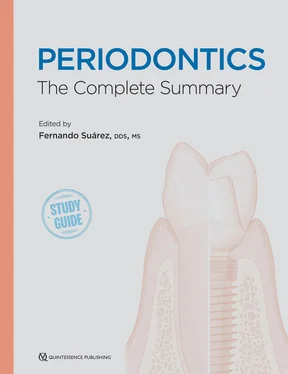It has been proposed that a maximum roughness threshold of Ra less than 0.2 μm be recommended to reduce plaque accumulation. 204Moreover, periodontal therapy might have an impact in roughness changes, resulting in increased plaque accumulation. These changes are also dependent on each dental material and treatment modality. 205An in vitro study using gold alloy specimens showed that pre- and posttreatment Ra values significantly increased after instrumentation with stainless steel curettes and prophylactic cups. 200Interestingly, stainless steel curettes increase roughness levels nearly 13 times greater than prophylactic cups.
Proceedings from the 2017 World Workshop on the classification of Periodontal and Peri-implant Diseases and Conditions concluded that dental materials act similar to enamel as plaque retentive factors to initiate gingivitis. 197
LOCATION OF THE RESTORATIVE MARGIN
The relationship between gingival health and the margin of the restoration has also been researched. 206–208Newcomb showed in 51 subjects that the more apical the margin of the restoration, the more gingival inflammation was present according to a gingival index. 209Four groups were classified depending on the distance of the crown margin to the base of the crevice (CM-BC) and found that margins as close as 0.75 mm or less can induce gingival inflammation.
A human histologic study 210showed that restorations placed below the gingival margin were likely to accumulate plaque subgingivally, even when routine oral hygiene was performed. It was also noted that individual sites can re-form plaque as soon as 6 weeks on subgingival restorations, while others can be free of plaque for as long as 2 years.
A 26-year longitudinal study examined the long-term effects of restorations with supra- and subgingival margins on periodontal health. 211It was concluded that subgingival margins exert a detrimental effect to gingival and periodontal health. Additionally, a “burn-out” effect was suggested as loss of attachment in teeth with subgingival margins was clinically detectable 1 to 3 years after the placement of the restoration.
SUBGINGIVAL PLAQUE AND DENTAL RESTORATIONS
The clinical and microbiologic effects of subgingival restorations have also been investigated. Lang et al found that placement of restorations with overhangingmargins resulted in changes in subgingival microflora. 196Also, increased proportions of gram-negative anaerobic bacteria, black-pigmented Bacteroides , and an increase in anaerobe:facultative ratio were noted. These changes may potentially initiate periodontal disease associated with iatrogenic factors. Similarly, the quality of plaque subjacent to bridge pontics from inflamed sites seems to harbor a higher proportion of periodontopathic bacteria (eg, Porphyromonas gingivalis , Prevotella intermedia , and Tannerrella forsythia ) when compared with healthy sites. 212
STATUS OF THE RESTORATIVE MARGIN
The proper contour and adaptation of the restorative margins may also influence the presence of other factors such as overhangs, open contacts, food retention/impaction, recurrent caries, and plaque retention—and thus play a role in periodontal breakdown. 213,214In this sense, Chan and Weber assessed crown margins and classified them into three groups based on the transition of the probe against the margin. 198The classification proposed included grade I, grade II, and grade III for margins with a smooth transition from restoration to tooth substance, margins with a slight irregularity, and gross imperfections of the crown margin, respectively.
An overhanging restoration that occupies the interproximal space might be conducive to periodontal breakdown and alveolar bone destruction. 215,216Studies reporting the prevalence of overhangs are included in Table 5-12. 216–218
TABLE 5-12 Prevalence of overhanging restorations
| Authors |
Prevalence |
| Gilmore and Sheiman 216 |
32% |
| Jeffcoat and Howell 217 |
71% |
| Pack et al 218 |
56% |
The classic study by Jeffcoat and Howell randomly selected 100 periodontal patients to assess the effect of amalgam overhangs on the alveolar bone height and classified their size into small (< 20%), medium (20%–50%), and large (> 50%) based on the interproximal space occupied by the overhang 217( Table 5-13). The authors showed that only medium and large overhanging restorations revealed significant bone loss when compared with control teeth.
TABLE 5-13 Classification of overhangs by Jeffcoat and Howell 217
| Size |
Percentage of interproximal space occupied by overhang |
| Small |
< 20% |
| Medium |
20%–50% |
| Large |
> 50% |
Pack et al evaluated 2,117 restored surfaces and reported that most of the overhangs were associated with pockets greater than 3 mm (64.3%) and bleeding on probing (32%). 218Also, Jansson et al concluded that sites with overhangs were associated with deeper probing depths, radiographic bone loss, and worsened parameters among susceptible periodontal patients. 219
Removal of overhangs in combination with plaque elimination results in significant reduction of gingival inflammation, 220–222and it is recommended during the initial phase of periodontal therapy. 223
OPEN INTERPROXIMAL CONTACTS
The link between open contacts and periodontal breakdown has been a topic of debate. Open contacts can be measured by the visual assessment 224or through the resistance of dental floss within the interproximal embrasure. 225Jernberg et al used a constructed gauge consisting of calibrated metal strips 0.1 mm thick. 224Interestingly, O’Leary et al chose a more practical assessment by using dental floss between the interproximal embrasure and classified into them tight (definitive resistance to floss), loose (minimal resistant to floss), or open contacts (no resistance to floss). 225
Despite the inability of early studies to find a direct correlation between open contacts and periodontal destruction, 226–228one classic study found that open contacts were directly related to food impaction, which in turn was significantly related to increased probing depths. 229However, there was no significant relationship between contact type and periodontal pocket depth. It should be noted that the subjects in that study had 80% of sites with moderate to severe gingival inflammation, indicating poor oral hygiene. This finding was confirmed in a cross-sectional study in a group of 104 subjects with 75% of anterior open contacts, demonstrating that food impaction was more frequent in open contacts (18.3%) than closed contacts (2.9%). 224
As a consequence of open contacts, plunger cuspsmay actively pass food into the embrasure area, causing food impaction. 11Hence, more plaque accumulation is expected when plunger cusps are present, and thus adequate and frequent plaque removal is paramount to maintain periodontal integrity within embrasure areas. 230It is also important to bear in mind that teeth requiring extraction with adjacent open contacts had significantly more attachment loss than sites with closed contacts. 231
MARGINAL RIDGE DISCREPANCIES
The importance of marginal ridge relationships relies on this factor being investigated as a predisposing factor for food impaction, 232attachment loss, and deeper probing depths. 233It is believed that interproximal wedging of food by a “plunger cusp” could be prevented if the integrity of proximal contacts and contour of marginal ridges are well maintained. 11A study by Kepic and O’Leary evaluated marginal ridge discrepancies in posterior teeth among 100 patients. The authors found a low correlation between marginal ridge discrepancies and periodontal parameters (probing depths, attachment loss, plaque/calculus accumulation, and gingival status). 234As such, it was suggested that the presence and extent of plaque and calculus deposits are more important in determining periodontal health than uneven marginal ridge discrepancies.
Читать дальше












